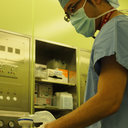Several Ryanodine Receptor Type 1 Gene Mutations of p.Arg2508 Are Potential Sources of Malignant Hyperthermia.
Keywords
Abstract
BACKGROUND
Malignant hyperthermia (MH) is a pharmacogenetic disorder that occurs in predisposed individuals after exposure to volatile anesthetics or depolarizing muscle relaxants. Genetic mutations of ryanodine receptor 1 (RYR1), which are considered to cause MH, are found mainly in 3 regions called "hotspots." There are sometimes multiple mutations at the same site of RYR1. Although p.Arg2508 of RYR1 is located outside hotspots, several mutations or variants (including the known MH causative mutation p.Arg2508Cys) have been identified in this region. We hypothesized that any mutations or variants in RYR1 p.Arg2508 cause important changes in pathological conditions related to MH. In this study, we analyzed the functions of 4 different RYR1 variants containing mutations at p.Arg2508.
METHODS
We prepared and analyzed the functions of 4 mutated RYR1 genes: p.Arg2508His and p.Arg2508Gly are MH-related variants, whereas p.Arg2508Ser and p.Arg2508Lys have not been previously reported. Because the biochemical characteristics of lysine are similar to arginine, we assumed that p.Arg2508Lys RYR1 would have characteristics most similar to those of the wild-type RYR1. We introduced these 4 mutated RYR1 genes, p.Arg2508His, p.Arg2508Gly, p.Arg2508Ser, and p.Arg2508Lys into rabbit RYR1 cDNA and transfected the resultant clones into human embryonic kidney 293 cells. Using the ratiometric dye Fura-2 AM, we used the 340/380 nm ratio to analyze alterations in calcium homeostasis after stimulation with caffeine and 4-chloro-m-cresol (4CmC). We calculated the half-maximal activation concentrations (EC50) of cells transfected with each mutant and compared the EC50 value of cells expressing each mutant with that of cells expressing wild-type RYR1. Statistical significance between EC50 values were calculated using an unpaired 2-tailed t test. We used 300 different cells, by 30 cells in each of the wild type or mutant.
RESULTS
Cells transfected with each of the 4 mutants, p.Arg2508His, p.Arg2508Gly, p.Arg2508Ser, or p.Arg2508Lys, were more sensitive to caffeine and 4CmC than cells transfected with the wild type (all 4 P ≤ 0.0004). Mean ± SD of EC50 values for caffeine of wild type, p.Arg2508His, p.Arg2508Gly, p.Arg2508Ser, and p.Arg2508Lys were 2.53 ± 0.89, 1.72 ± 0.72, 1.73 ± 0.79, 1.69 ± 0.80, and 1.61 ± 0.74 mM, respectively, and those for 4CmC were 125.92 ± 38.11, 70.42 ± 27.09, 79.30 ± 39.04, 73.03 ± 19.20, and 72.81 ± 28.44 mM, respectively.
CONCLUSIONS
Any of these 4 mutations in RYR1 p.Arg2508 may cause important changes related to MH. Studying the effects of changes in amino acids at 2508 in RYR1 on the movement of this large protein may lead to a better understanding of the pathology of MH events.




